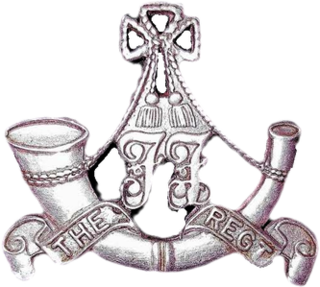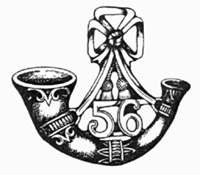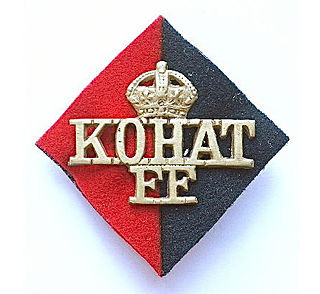
The North-West Frontier was a region of the British Indian Empire. It remains the western frontier of present-day Pakistan, extending from the Pamir Knot in the north to the Koh-i-Malik Siah in the west, and separating the modern Pakistani frontier regions of North-West Frontier Province, Federally Administered Tribal Areas and Balochistan from neighbouring Afghanistan in the west. The borderline between is officially known as the Durand Line and divides Pashtun inhabitants of these provinces from Pashtuns in eastern Afghanistan.

The 55th Coke's Rifles (Frontier Force) was a regiment of the British Indian Army. It was raised in 1849 as the 1st Regiment of Punjab Infantry. It was designated as the 55th Coke's Rifles (Frontier Force) in 1903 and became 1st Battalion (Coke's) 13th Frontier Force Rifles in 1922. In 1947, it was allocated to the Pakistan Army, where it continues to exist as 7th Battalion The Frontier Force Regiment.

The Frontier Force Regiment is one of the six infantry regiments of the Pakistan Army. They are popularly known as the Piffers in reference to their military history as the PIF of the British Indian Army, or as the FF. The regiment takes its name from the historic North-West Frontier, a former province of British India and later Pakistan.

The Guides Cavalry (Frontier Force) is an armoured regiment of the Pakistan Army which was raised in 1846 as The Corps of Guides. During more than a hundred and fifty years of military service, the regiment has earned the reputation of one of the most renowned military units in the world.

The 11th Cavalry (Frontier Force), is an armoured regiment of the Pakistan Army. It was previously known as the 11th Prince Albert Victor's Own Cavalry and was a regular cavalry regiment of the old British Indian Army. It was formed in 1849 and later 21st Prince Albert Victor's Own Cavalry (Frontier Force) and the 23rd Cavalry were amalgamated.

The 56th Punjabi Rifles (Frontier Force) was an infantry regiment of the British Indian Army. It was raised in 1849 as the 2nd Regiment of Punjab Infantry. It was designated as the 56th Punjabi Rifles (Frontier Force) in 1906 and became 2nd Battalion 13th Frontier Force Rifles in 1922. In 1947, it was allocated to the Pakistan Army, where it continues to exist as 8th Battalion The Frontier Force Regiment.

The 4th Punjab Infantry Regiment was an infantry regiment of the British Indian Army formed on 18 April 1849 by Captain GG Denniss at Lahore as part of the Transfrontier Brigade, which became the Punjab Irregular Force (PIF) in 1851. The regiment was designated as the 57th Wilde's Rifles (Frontier Force) in 1903, and 4th Battalion (Wilde's) 13th Frontier Force Rifles in 1922. In 1947, it was allocated to the Pakistan Army, where it continues to exist as 9th Battalion The Frontier Force Regiment.

The 51st Sikhs (Frontier Force) was an infantry regiment of the British Indian Army. It was raised in 1846 as the 1st Regiment of Infantry The Frontier Brigade. It was designated as the 51st Sikhs (Frontier Force) in 1903 and became 1st Battalion (Prince of Wales's Own Sikhs) 12th Frontier Force Regiment in 1922. In 1947, it was allocated to the Pakistan Army, where it continues to exist as 3 Battalion The Frontier Force Regiment.

The 59 Scinde Rifles (Frontier Force) was an infantry regiment of the British Indian Army. It was raised in 1843, as the Scinde Camel Corps. In 1856, it was incorporated into the Punjab Irregular Force (PIF). It was designated as the 59th Scinde Rifles (Frontier Force) in 1904 and became 6th Royal Battalion (Scinde) 13th Frontier Force Rifles in 1922. In 1947, it was allocated to the Pakistan Army, where it continues to exist as 1st Battalion The Frontier Force Regiment.

The 52nd Sikhs (Frontier Force) was an infantry regiment of the British Indian Army. It was raised in 1846 as the 2nd Regiment of Infantry The Frontier Brigade. It was designated as the 52nd Sikhs (Frontier Force) in 1903 and became 2nd Battalion (Sikhs) 12th Frontier Force Regiment in 1922. In 1947, it was allocated to the Pakistan Army, where it continues to exist as 4th Battalion The Frontier Force Regiment.
The 53rd Sikhs (Frontier Force) was an infantry regiment of the British Indian Army. It was raised in 1847 as the 3rd Regiment of Infantry The Frontier Brigade. It was designated as the 53rd Sikhs (Frontier Force) in 1903 and became 3rd Battalion (Sikhs) 12th Frontier Force Regiment in 1922. In 1947, it was allocated to the Pakistan Army, where it continues to exist as 5th Battalion The Frontier Force Regiment.

The 54th Sikhs (Frontier Force) were an infantry regiment of the British Indian Army. It was raised in 1846 as the 4th Regiment of Infantry The Frontier Brigade. It was designated as the 54th Sikhs (Frontier Force) in 1903 and became 4th Battalion (Sikhs) 12th Frontier Force Regiment in 1922. In 1947, it was allocated to the Pakistan Army, where it continues to exist as 6th Battalion The Frontier Force Regiment.

The 58th Vaughan's Rifles (Frontier Force) was an infantry regiment of the British Indian Army. It was raised in 1849 as the 5th Regiment of Punjab Infantry. It was designated as the 58th Vaughan's Rifles (Frontier Force) in 1903 and became 5th Battalion 13th Frontier Force Rifles in 1922. In 1947, it was allocated to the Pakistan Army, where it continues to exist as 10th Battalion The Frontier Force Regiment.

The 21st Kohat Mountain Battery (Frontier Force) was an artillery unit of the British Indian Army. It was raised in 1851 as the No. 2 Horse or Punjab Light Field Battery, Punjab Irregular Force. It became the 21st Kohat Mountain Battery (Frontier Force) in 1903. In 1947, it was transferred to the Pakistan Army, where it exists as the 2nd Royal Kohat Battery (Frontier Force) of The First (SP) Medium Regiment Artillery (Frontier Force).
The 24th Hazara Mountain Battery (Frontier Force) was an artillery battery of the British Indian Army.
The 26th Jacob's Mountain Battery was an artillery unit of the British Indian Army. The battery can trace its origins back to Golandauze Battalion (1826). In 1843 it became the 10th Company Golandauze Battalion of Bombay Foot Artillery, and became the 26th Jacob's Mountain Battery in 1903. In 1947, it was transferred to the Pakistan Army, where it exists as the 1st Jacob's Battery (Baloch) of The First (SP) Medium Regiment Artillery.

The Guides Infantry, or 2nd Battalion (Guides) The Frontier Force Regiment, is an infantry battalion of the Pakistan Army. It was raised in 1846 as part of the famous Corps of Guides, a highly mobile force to act as guides to troops in the field and gather intelligence beyond the borders of British India. The corps recruited men from various backgrounds, with Pathans, Punjabi Muslims, Sikhs, and Dogras forming the majority of their manpower. Under the leadership of Lieutenant Harry Burnett Lumsden, the Guides gained a formidable reputation and introduced the dust-colored "khaki" uniforms, later adopted by the British Army in India. The corps became part of the Punjab Frontier Force, known as Piffers, which maintained order on the Punjab Frontier for fifty years.
56 Field Regiment (Jitra) is part of the Regiment of Artillery of the Indian Army.
23 Field Regiment is part of the Regiment of Artillery of the Indian Army.














